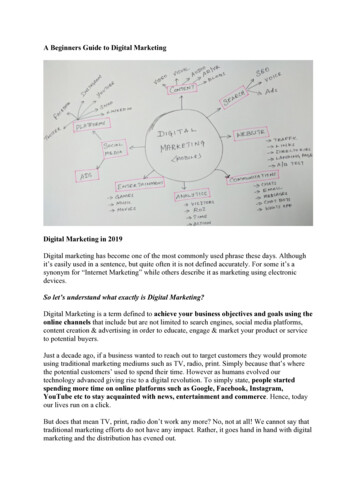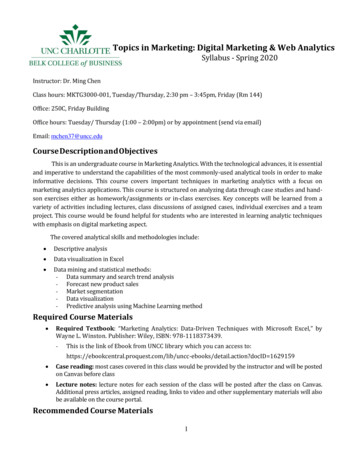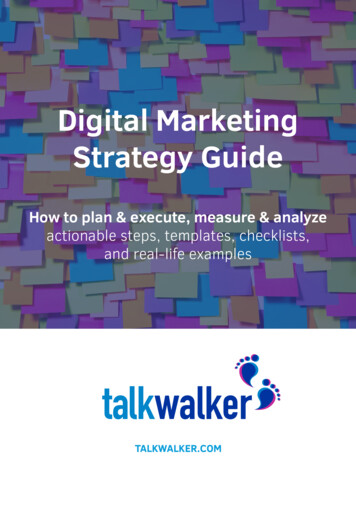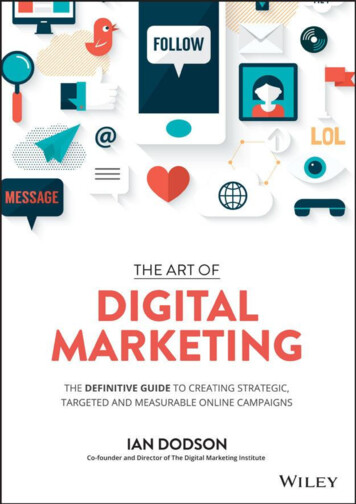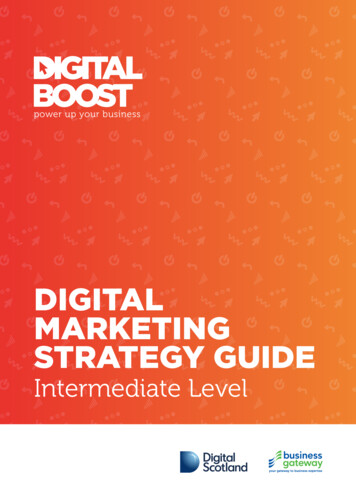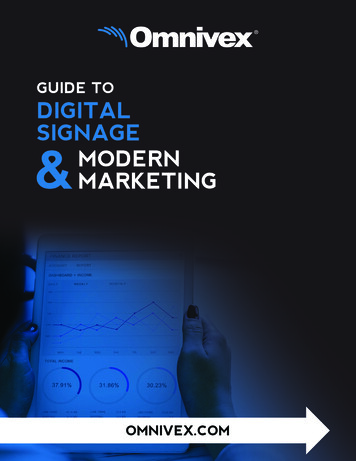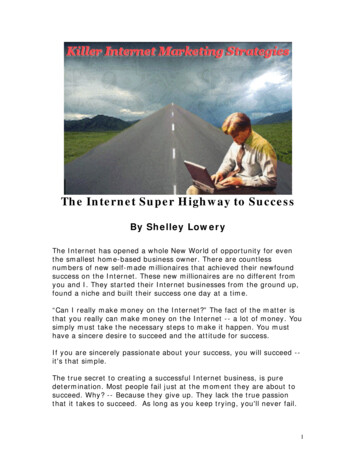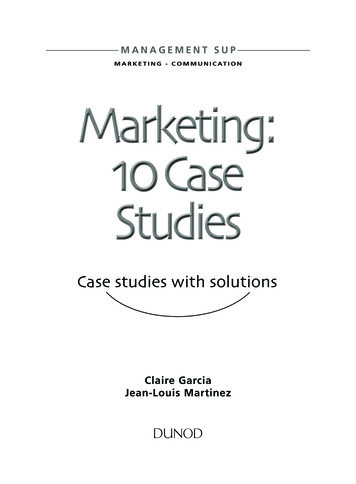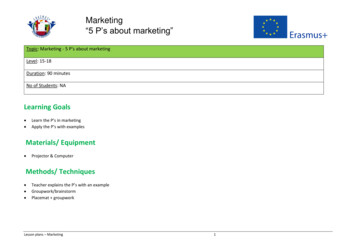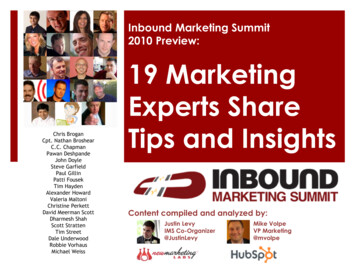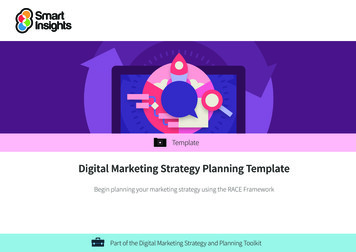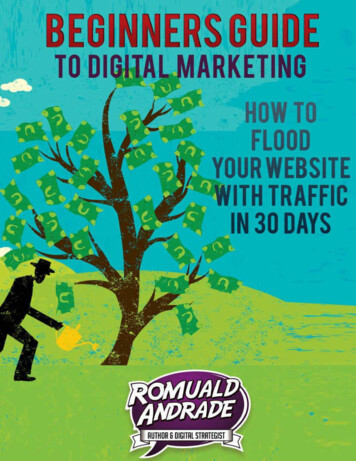
Transcription
BEGINNERS GUIDETO D I G I TA L M A R K E T I N G :H O W TO F L O O D Y O U R W E B S I T E W I T H T R A F F I C I N 3 0 D AY SCOPYRIGHT 2015 ROMUALD ANDRADEA L L R I G H T S R E S E RV E D .
To my daughter, Erika,You have taught me so many things:What truly matters in life,To find pleasure in simple things,To find humor in any situation,And to trust that tomorrow will be a better day.Thank you for just being you. I am proud and happy to be your dad.- Romuald
TABLE OF CONTENTSSECTION 1SECTION 2Day 1: The Creative BriefDay 2: The Success TrackerDay 3: The Keyword ListDay 4: Your Domain NameDay 5: Call To ActionDay 6: The Content CalendarDay 7: Sources Of TrafficPITSTOP 1Day 8: List BuildingDay 9: Google AdwordsDay 10: Google Webmaster ToolsDay 11: Google AnalyticsDay 12: CRM
Day 13: Conversion Rate OptimizationDay 14: The Buying CyclePITSTOP 2Day 16: AutoresponderDay 17: Email ContentDay 18: SEODay 19: FacebookDay 20: LinkedINDay 21: TwitterPITSTOP 3Day 22: PinterestDay 23: Google PlusDay 24: HootsuiteDay 25: Lead QualificationDay 26: ReportsDay 27: Brand and Non-BrandDay 28: MeasurePITSTOP 4Day 29: Customer BehaviorDay 30: The Review
SECTION 3
Your Free GiftAs a way of saying, “Thanks for your purchase,” I’m offering a freedownload of my marketing template.This template is the exact same tool I used to help over 200 clients (of which12 were well-known nationwide brands) to get more value out of their digitalmarketing efforts.You can download this template by going here:http://www.authorandfriend.com/brief/If you have received some value from this Kindle book, I’d love to have areview from you on Amazon.com.I look forward to your comments and feedback. You can send me an email atauthorandfriend@gmail.com.
Who can this book help?If you have never done digital marketing before and need a simple book thatgets to the point and shows you the steps to getting it done, then this book isperfect for you.If you have already done some form of inbound marketing but you need aframework, then this book will help you.If you want to compress years of trial and error into days, then this bookmight be for you.If you have done event marketing or print-based marketing, which meansyou already have a marketing base and you just want a primer in digitalmarketing, then this book is for you.Or maybe you are a business owner and you need a launch a new product inthe next 30 days. This book will give you the framework you need tosuccessfully manage and keep track of the marketing aspects of your productlaunch.When I started writing this book, I wrote out only the 30-day plan and Ithought that I was finished. After reading through it a few times, I realized that Iwas making critical assumptions about you. If these assumptions were wrong,then it would render this whole book useless.To correct this error, I have listed the things you must understand before youbegin.First off, I want you to know that I believe that you are a self-motivatedperson. I believe that you are doing this because you have a lot of responsibilityto handle and the success of your digital marketing efforts is critical for bothyour company and yourself.1. I assume that you have basic technology skills. You can use the Internet,find items in a search engine, and send an email.2. I assume that you have a product or service or a niche that you aretargeting. In other words, before doing anything else, you must know what
audience you are targeting, because you cannot do marketing without having thisin mind.3. I assume you have social media accounts already established onFacebook, LinkedIn and YouTube. While I will explain what to do with theseaccounts, setting them up is beyond the scope of this book.4. I assume you are taking a long-term view of your digital marketingefforts. This is important because if you are just looking for a one-off solution,then this book may not be right for you.5. I assume that you are willing to take a calculated risk with paid mediaand are not looking only for free solutions. What I have learned is that evenfree things cost money because there is the cost of the lost opportunity when youinvest your TIME and don’t get the level of results that you expect.
How To Use This BookThis book is divided into three parts.Section 1 focuses on the prerequisites you need to have in place before youstart your digital marketing activities.Section 2 gives you a day-wise action plan. Ideally, you will follow my dayby-day instructions for the first 30 days. After the initial 30 days, you cancontinue to follow my day-by-day instructions or you can focus on thoseactivities that worked better for you.Section 3 gives you a list of resources so that it is easier for you to execute.In addition to this book, you can visit my website, listed below; to accessmany other free downloads.http://www.authorandfriend.com/brief/
How Will You Benefit From This Book?The book is more strategic than hands-on. You will find the materialorganized into several categories designed to walk you through the process.Here’s just a taste of what you’ll discover # How to structure your inbound marketing efforts with a simple 30-day plan# Secrets of digital marketing management few people know about# How to bring a level of sanity to your product launch efforts in just a fewshort minutes# A strategic framework for the first 30 days of your marketing plan.# Marketing strategies and tactics worth ! Trust me, I have seen howmuch money businesses waste on marketing, and it can cost in the tens ofthousands of dollars.You’re going to want to know something before you purchase this book: It’sgoing to be a lot of work, so be prepared to allocate 30 days of dedicated timeand effort to this activity.Digital Marketing isn’t always easy or clear cut at first, but with time andenergy spent learning and practicing the step-by-step method I’ll show you,you’ll understand how to measure the performance of your team and get theresults you need from your efforts on a consistent basis.I will explain to you my own pitfalls and perils in the case study section,along with advice I found while I was looking for solutions to my ownchallenges when executing such projects. These should hopefully make thingssimpler for you, since you will not have to learn from trial and error; however, Iwould like to underline that just because it is simple does not mean it will beeasy.Now, this begs the question: is it worth the effort? And my answer is yes; itis definitely worth it.I invite you to join me on this journey as we learn about Digital Marketing.
SECTION 1
My Digital Marketing BackgroundIt’s important to know who you are listening to when you get digitalmarketing advice. That’s why I want to start with my story.I published my first website in the year 2003. After publishing my website, Isent the link to my friends for their feedback, which resulted (eventually) in a lotof inquiries from small business owners who wanted to have websites for theirown businesses. As a freelancer, I was happy to help people by creating theirwebsites, but a few of them would come back to me after a year and say thatthey did not want to renew the website for the next year.This caught me by surprise, because I would get approval from them at everystage of building the website (about six stages in total) and I would not proceedfrom one to another unless they had approved the previous stage. So how couldit be that they were now unhappy with a website that they were ecstatic about ayear earlier?The answer was they felt that that their websites did not make money forthem and were therefore a wasted expense. But on drilling down further, Irealized that the websites had helped them in their branding and marketingefforts, but they did not have a way of measuring how successful their websiteswere.The solution I found at the time was to install Google Analytics on everywebsite that I made from that point on, which led to my interest in SEO (SearchEngine Optimization) followed by social media marketing and paid media. Ijoined an agency as a Project Manager and got a lot more exposure to digitalmarketing while handling marketing campaigns for multinational companies.The average number of website visits for some of these companies was about 2million users per month.I also developed a questionnaire, which I would ask every client to fill outbefore starting his or her project. This document also helped me a lot when Istarted working with small business owners, and I was able to offer them accessto tools and help them out as a digital marketing consultant. As of now, I havesuccessfully used the questionnaire in over 200 companies in 14 differentindustries, which has given me confidence that my method works.
This document is provided as a free download on my website as my way ofsaying, “Thanks for purchasing this book.”http://www.authorandfriend.com/brief/
Lessons LearnedThroughout this book, I’ll be sharing what’s worked for me and what is mostlikely to work for you. But three lessons stand out above the rest.Lesson 1: Do a weekly review of your project, which I refer to as aPitstop.A marketing project that’s not exceptionally successful is probably headingdown the wrong direction because of one or more of its lead sources/channelsnot operating at its peak. Taking charge and checking fairly often is the key toget the plan back on the right track. A pitstop will help you do that. You need tomainly use a quantitative approach to measure your success.Lesson 2: Get quality traffic.Quality traffic is the key to digital marketing. By “traffic,” I mean thevisitors coming to your website. If these visitors don’t have the intent to buy,then it is not quality traffic.Lesson 3: Know the difference between Strategy, Tactics, and Execution.The initial project plan used at the product launch stage usually getshopelessly out of whack due to poor execution. (A combination of good strategyand poor execution is like a Ferrari with flat tires: it looks good in the specs, butfails on the street.) Often, people pass off tactics as strategy, and so end upskipping strategy altogether. Tactical decisions are the day-to-day decisionsrequired for the marketing campaign, whereas strategy is generally consistent forthe entire year and rarely changes.Sometimes, you need to know which marketing activity will have the bestresults even before you commit to it fully. The solution is a pilot program or anexperiment with a small budget before you scale up the activity.
PrerequisitesDigital marketing requires various tools and resources to be available for usedepending on the activities undertaken. We will be looking at these activities inthe 30-day plan; however, we need to ensure that we have a few basics in placebefore we undertake the 30-day plan.There are three basic things you need to have in place before we begin.1) A logo for each segment of your business.2) Team members with different specialties who can prioritize and handletasks efficiently.3) A Gmail ID specifically created for the purpose of digital marketing.Since you might need to share this ID and password with your team, it makessense to keep it separate from your personal or official IDs.I will explain these in detail.LogoWhen a client approaches me and he does not have a logo or has a logo thatlooks like clipart, it immediately sets off alarms in my head.To be fair to these clients, I will list some of their reasons:1) They do not want to invest in promoting and managing multiple brands.2) They have been using the same clipart logo for years without anyproblems.3) They are just starting out so they don’t know if it is worth the investment.4) No one in their industry uses a logo.5) They have never felt the need for a logo.All of the above may be perfectly valid reasons, given the mindset of a nonmarketing person. But as any good marketing person will tell you, you NEED tohave a logo for every SEGMENT of your business.Now before you write me off, let me explain. You can have a “Group Logo”for your main business that stays constant, but with a tagline that changes for
every segment within that business. That would still give you an edge over thecompetition. But by no means should you try to avoid having logos for differentbusiness segments, and here are the top three reasons why:# In the process of creating a logo for your brand, you end up defining thatbrand or segment for your company.# You clearly associate an image of what your brand should look like or feellike to your end customer.# More importantly, you also define what your brand is NOT, or what it doesnot stand for.Your Team: Should you outsource?Outsourcing is quite popular now. But let us first understand what it is allabout and whether it can work for you and your company.Many small business owners are anxious to get started and want to start offas a one-man army. Other companies with existing in-house staff try to get theirstaff to execute digital strategy without really knowing if that person or personsare right for the job. There are also companies that create an in-house digitaldepartment from scratch with students fresh out of college.Digital marketing is a relatively new industry and it can be quite challengingto find the right staff for it. The best solution is to have one in-house digitalspecialist and then outsource the execution to either an agency or freelancespecialists. The in-house expert monitors the digital campaigns, makes sure thatan integrated digital strategy is followed, and mobilizes the company’s existingresources to deliver what the agency or freelancer needs.A Virtual TeamA virtual team, or a remote team, is a team that works virtually. It is usuallygeographically diverse and so may never meet face-to-face. Outsourcing to avirtual team has its pros and cons.Advantages of virtual teams:
# Increased productivity. Virtual teams have flexible work schedules. Withthe “follow the sun”
Quality traffic is the key to digital marketing. By “traffic,” I mean the visitors coming to your website. If these visitors don’t have the intent to buy, then it is not quality traffic. Lesson 3: Know the difference between Strategy, Tactics, and Execution. The initial project plan used at
